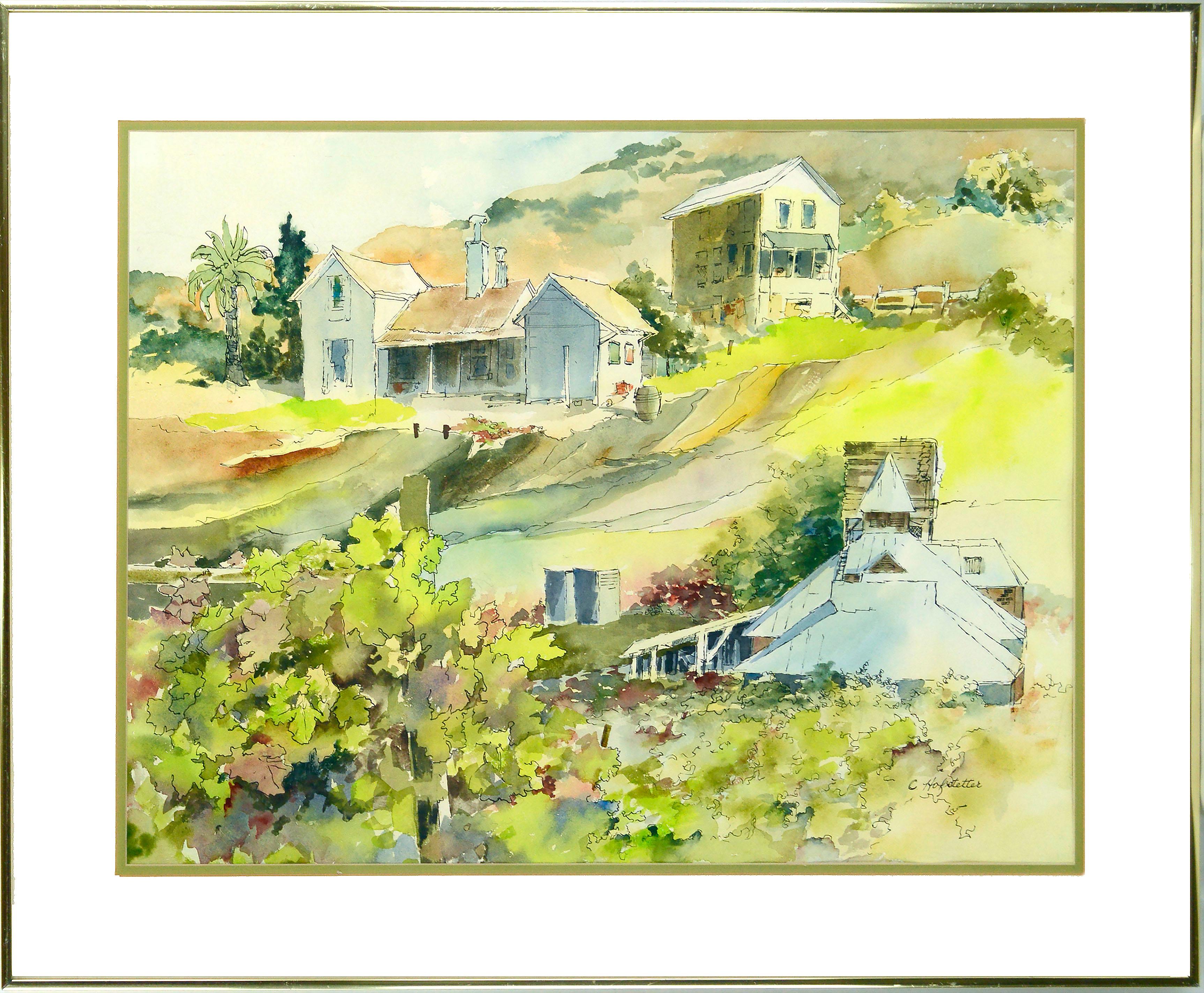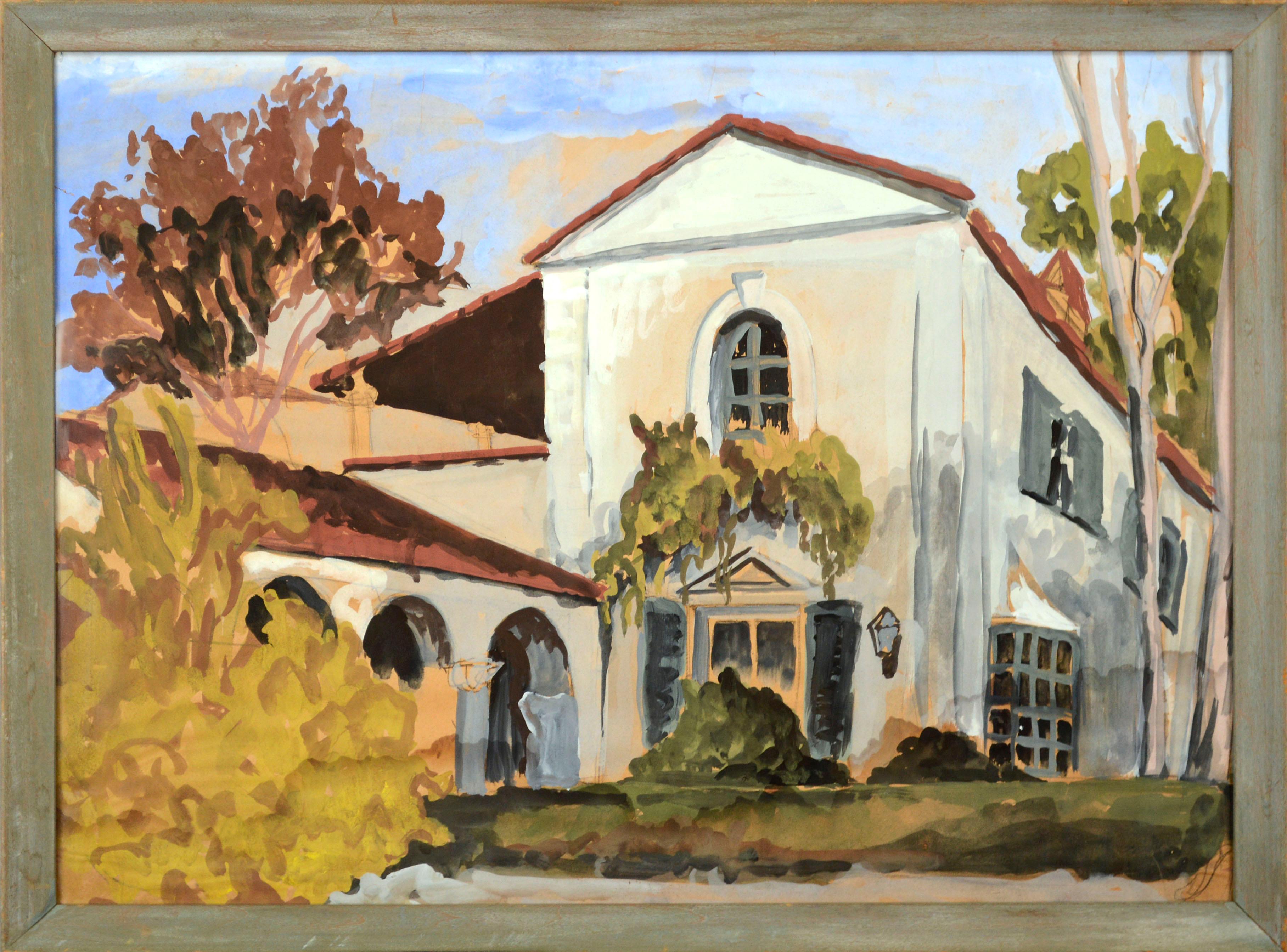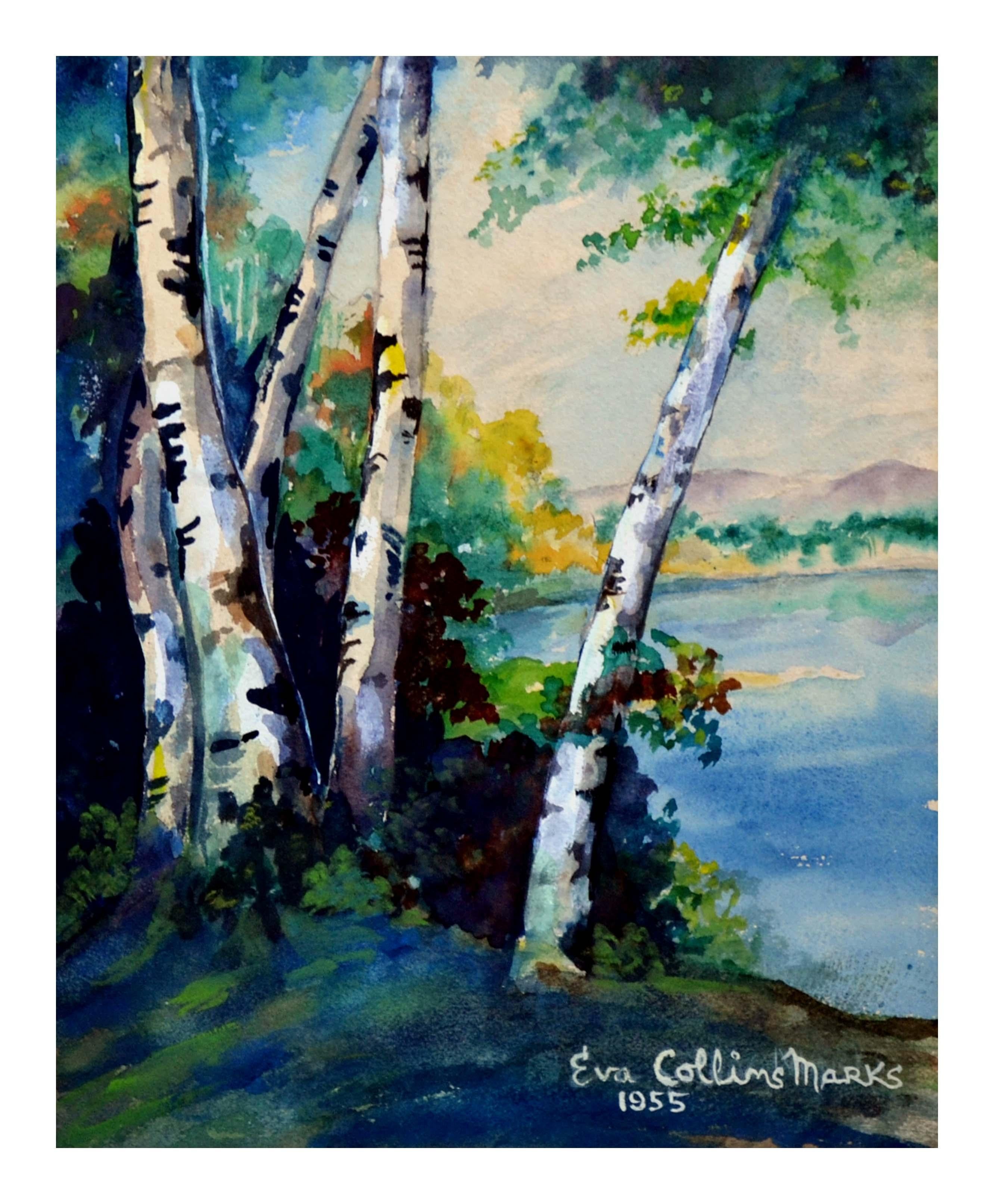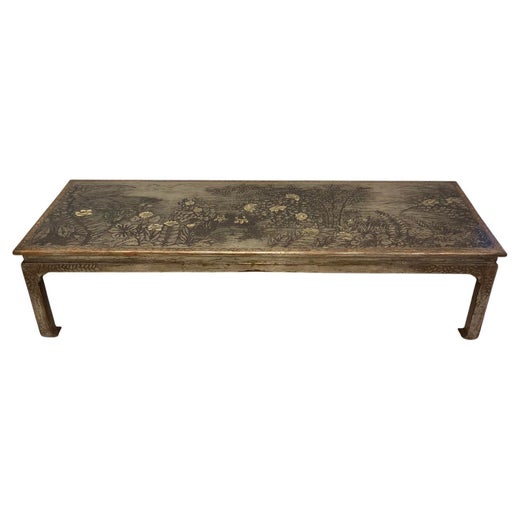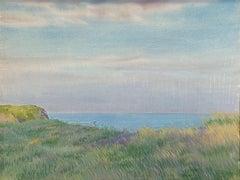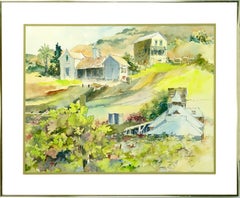Items Similar to "Train Station, " Max Kuehne, Industrial City Scene, American Impressionism
Want more images or videos?
Request additional images or videos from the seller
1 of 8
Max Kuehne"Train Station, " Max Kuehne, Industrial City Scene, American Impressionismcirca 1910
circa 1910
About the Item
Max Kuehne (1880 - 1968)
Train Station, circa 1910
Watercolor on paper
8 1/4 x 10 1/4 inches
Signed lower right
Provenance:
Private Collection, Illinois
Max Kuehne was born in Halle, Germany on November 7, 1880. During his adolescence the family immigrated to America and settled in Flushing, New York. As a young man, Max was active in rowing events, bicycle racing, swimming and sailing. After experimenting with various occupations, Kuehne decided to study art, which led him to William Merritt Chase's famous school in New York; he was trained by Chase himself, then by Kenneth Hayes Miller. Chase was at the peak of his career, and his portraits were especially in demand. Kuehne would have profited from Chase's invaluable lessons in technique, as well as his inspirational personality. Miller, only four years older than Kuehne, was another of the many artists to benefit from Chase's teachings. Even though Miller still would have been under the spell of Chase upon Kuehne's arrival, he was already experimenting with an aestheticism that went beyond Chase's realism and virtuosity of the brush. Later Miller developed a style dependent upon volumetric figures that recall Italian Renaissance prototypes.
Kuehne moved from Miller to Robert Henri in 1909. Rockwell Kent, who also studied under Chase, Miller, and Henri, expressed what he felt were their respective contributions: "As Chase had taught us to use our eyes, and Henri to enlist our hearts, Miller called on us to use our heads." (Rockwell Kent, It's Me O Lord: The Autobiography of Rockwell Kent. New York: Dodd, Mead and Co., 1955, p. 83). Henri prompted Kuehne to search out the unvarnished realities of urban living; a notable portion of Henri's stylistic formula was incorporated into his work.
Having received such a thorough foundation in art, Kuehne spent a year in Europe's major art museums to study techniques of the old masters. His son Richard named Ernest Lawson as one of Max Kuehne's European traveling companions. In 1911 Kuehne moved to New York where he maintained a studio and painted everyday scenes around him, using the rather Manet-like, dark palette of Henri.
A trip to Gloucester during the following summer engendered a brighter palette. In the words of Gallatin (1924, p. 60), during that summer Kuehne "executed some of his most successful pictures, paintings full of sunlight . . . revealing the fact that he was becoming a colorist of considerable distinction." Kuehne was away in England the year of the Armory Show (1913), where he worked on powerful, painterly seascapes on the rocky shores of Cornwall. Possibly inspired by Henri - who had discovered Madrid in 1900 then took classes there in 1906, 1908 and 1912 - Kuehne visited Spain in 1914; in all, he would spend three years there, maintaining a studio in Granada. He developed his own impressionism and a greater simplicity while in Spain, under the influence of the brilliant Mediterranean light. George Bellows convinced Kuehne to spend the summer of 1919 in Rockport, Maine (near Camden). The influence of Bellows was more than casual; he would have intensified Kuehne's commitment to paint life "in the raw" around him.
After another brief trip to Spain in 1920, Kuehne went to the other Rockport (Cape Ann, Massachusetts) where he was accepted as a member of the vigorous art colony, spearheaded by Aldro T. Hibbard. Rockport's picturesque ambiance fulfilled the needs of an artist-sailor: as a writer in the Gloucester Daily Times explained, "Max Kuehne came to Rockport to paint, but he stayed to sail." The 1920s was a boom decade for Cape Ann, as it was for the rest of the nation. Kuehne's studio in Rockport was formerly occupied by Jonas Lie.
Kuehne spent the summer of 1923 in Paris, where in July, André Breton started a brawl as the curtain went up on a play by his rival Tristan Tzara; the event signified the demise of the Dada movement. Kuehne could not relate to this avant-garde art but was apparently influenced by more traditional painters — the Fauves, Nabis, and painters such as Bonnard. Gallatin perceived a looser handling and more brilliant color in the pictures Kuehne brought back to the States in the fall. In 1926, Kuehne won the First Honorable Mention at the Carnegie Institute, and he re-exhibited there, for example, in 1937 (Before the Wind). Besides painting, Kuehne did sculpture, decorative screens, and furniture work with carved and gilded molding. In addition, he designed and carved his own frames, and John Taylor Adams encouraged Kuehne to execute etchings. Through his talents in all these media he was able to survive the Depression, and during the 1940s and 1950s these activities almost eclipsed his easel painting. In later years, Kuehne's landscapes and still-lifes show the influence of Cézanne and Bonnard, and his style changed radically.
Max Kuehne died in 1968. He exhibited his work at the National Academy of Design, the Art Institute of Chicago, the Carnegie Institute in Pittsburgh, the Memorial Art Gallery of the University of Rochester, and in various New York City galleries. Kuehne's works are in the following public collections: the Detroit Institute of Arts (Marine Headland), the Whitney Museum (Diamond Hill, 1919, and Main Street, Gloucester, 1929), the Los Angeles County Museum, and the Victoria and Albert Museum in London. Several of the Spanish landscapes went to the Hispanic Society of America.
- Creator:Max Kuehne (1880-1968, American)
- Creation Year:circa 1910
- Dimensions:Height: 13.5 in (34.29 cm)Width: 15.5 in (39.37 cm)
- Medium:
- Movement & Style:
- Period:
- Condition:Excellent.
- Gallery Location:New York, NY
- Reference Number:1stDibs: LU184129923782
Max Kuehne
Born in Halle, Germany in 1880, Max Kuehne was a colorist who created cheerful landscapes that appear to be painted spontaneously and with freshness. He studied with William Merritt Chase and Kenneth Hayes at the Chase School in New York. In 1910, he embarked on a bicycling trip, traveling through England, France, Germany, Holland and Belgium. To support this trip he did portrait commissions along the way. When he returned to New York City, he set up a studio in Greenwich Village and was a student of Robert Henri from whom he learned a dark impressionist style. He also became close with such avant garde artists as Guy Pene du Bois, William Glackens, William Zorach and Maurice and Charles Prendergast, which also influenced his dark work including street scenes and docks in New York City. However, three years in Spain, and painting trips to Gloucester lightened his palette as did time in Paris where he was much influenced by the Fauves, Nabis, and decorative painters. By 1912 he was producing work that would make him known as a "colourist of great distinction" by producing "paintings full of sparkling sunlight." He became a member of the artistic community later in Rockport, Massachusetts, with Gifford Beal, Leon Kroll, Paul Manship, Edward Hopper and Jonas Lie. Many of his finest paintings done later in his career are of the busy harbors and piers of Gloucester and Rockport. His work was widely exhibited including the National Academy of Design, the Art Institute of Chicago, and the Carnegie Institute in Pittsburgh.
About the Seller
5.0
Gold Seller
Premium sellers maintaining a 4.3+ rating and 24-hour response times
Established in 2022
1stDibs seller since 2022
98 sales on 1stDibs
Typical response time: <1 hour
- ShippingRetrieving quote...Shipping from: New York, NY
- Return Policy
Authenticity Guarantee
In the unlikely event there’s an issue with an item’s authenticity, contact us within 1 year for a full refund. DetailsMoney-Back Guarantee
If your item is not as described, is damaged in transit, or does not arrive, contact us within 7 days for a full refund. Details24-Hour Cancellation
You have a 24-hour grace period in which to reconsider your purchase, with no questions asked.Vetted Professional Sellers
Our world-class sellers must adhere to strict standards for service and quality, maintaining the integrity of our listings.Price-Match Guarantee
If you find that a seller listed the same item for a lower price elsewhere, we’ll match it.Trusted Global Delivery
Our best-in-class carrier network provides specialized shipping options worldwide, including custom delivery.More From This Seller
View All"Monhegan Island, Maine, " Edward Dufner, American Impressionism Landscape View
By Edward Dufner
Located in New York, NY
Edward Dufner (1872 - 1957)
Monhegan Island, Maine
Watercolor on paper
Sight 16 x 20 inches
Signed lower right
With a long-time career as an art teacher and painter of both 'light' and 'dark', Edward Dufner was one of the first students of the Buffalo Fine Arts Academy to earn an Albright Scholarship to study painting in New York. In Buffalo, he had exchanged odd job work for drawing lessons from architect Charles Sumner. He also earned money as an illustrator of a German-language newspaper, and in 1890 took lessons from George Bridgman at the Buffalo Fine Arts Academy.
In 1893, using his scholarship, Dufner moved to Manhattan and enrolled at the Art Students League where he studied with Henry Siddons Mowbray, figure painter and muralist. He also did illustration work for Life, Harper's and Scribner's magazines.
Five years later, in 1898, Dufner went to Paris where he studied at the Academy Julian with Jean-Paul Laurens and privately with James McNeill Whistler. Verification of this relationship, which has been debated by art scholars, comes from researcher Nancy Turk who located at the Smithsonian Institution two 1927 interviews given by Dufner. Turk wrote that Dufner "talks in detail about Whistler, about how he prepared his canvasas and about numerous pieces he painted. . . A great read, the interview puts to bed" the ongoing confusion about whether or not he studied with Whistler.
During his time in France, Dufner summered in the south at Le Pouleu with artists Richard Emil Miller...
Category
Early 20th Century American Impressionist Landscape Drawings and Waterco...
Materials
Watercolor, Paper
"Gloucester Harbor at Sunset, " John Hare, Cape Ann, New England Watercolor View
Located in New York, NY
John Hare
Gloucester Harbor at Sunset, Massachusetts
Signed lower right
Watercolor on paper
16 x 12 inches
John Cuthbert Hare, 1908-1978, was a watercolorist who painted boats, seascapes and harbor scenes. He was primarily associated New England, especially Cape Cod, Massachusetts where he spent his summers from 1938 to 1965. However, he was in Florida where he was a member of the St. Augustine Art Association, and other locations on the East Coast.
It is likely Hare was born in New York City. He first studied commercial art in Brooklyn at the Pratt Institute and also studied at the Art Students League in Manhattan. He worked for Hearst newspapers corporation, and in 1933 married. In the next few years, he and his wife traveled extensively, camping and painting and exhibiting his work in galleries.
In 1935, they visited St. Augustine and an exhibition of his watercolors was held there in the old bank...
Category
Mid-20th Century Impressionist Landscape Drawings and Watercolors
Materials
Paper, Watercolor
"Gray Morning" James MacMaster, Scottish Seascape, Marine Ship Landscape
By James MacMaster
Located in New York, NY
James MacMaster
Gray Morning
Signed and titled lower left
Watercolor on paper
10 1/4 x 14 inches
Provenance:
Private Collection, New Jersey
Category
Late 19th Century Landscape Paintings
Materials
Paper, Watercolor
$540 Sale Price
70% Off
"Irvine Harbour" James MacMaster, Scottish Seascape, Marine Ship Painting
By James MacMaster
Located in New York, NY
James MacMaster
Irvine Harbour
Signed lower right
Watercolor on paper
10 1/4 x 14 inches
Provenance:
Private Collection, New Jersey
Category
Late 19th Century Landscape Paintings
Materials
Paper, Watercolor
$540 Sale Price
70% Off
"Gondolas at the Dock, Venice, Italy" Louis Wolchonok, Boats in the Harbor Scene
By Louis Wolchonok
Located in New York, NY
Louis Wolchonok (1898 - 1973)
Gondolas at the Dock, Venice, Italy, 1928
Watercolor on paper
Sight 18 x 23 1/2 inches
Signed and dated lower right
Louis Wolchonok was an author of ar...
Category
1920s Post-Impressionist Landscape Drawings and Watercolors
Materials
Paper, Watercolor
"Andes Mountains Peru South America, " Joseph Yoakum, Black Folk Art Landscape
By Joseph Yoakum
Located in New York, NY
Joseph Yoakum
Andes Mountains Peru So America, circa 1960s
Colored pencil and ballpoint pen on paper
7 1/4 x 10 1/2 inches
Provenance:
Karen Lennox Gallery, Chicago
Private Collection, South Dakota
Yoakum began drawing in the early 1960s. Most of his work consists of radiantly colored landscapes with mountains, water, trees, and winding roads in abstract and complex configurations. his period of greatest activity — 1965 to 1970 — when he usually made one drawing a day.
Yoakum maintained he had seen all the places represented in his drawings, a statement that may not be true in some instances. He traveled a great deal, beginning in his early teens when he ran away from home and became a circus handyman. Yoakum’s drawings can be considered memory images growing out of either actual or imagined experiences. All of his drawings have titles that grew longer and more specific over the years. He dated his works with a rubber stamp — an oddly impersonal, labor-saving device.
Although Joseph Yoakum gave vastly different accounts of his background, he was, throughout his life, classified as an African American. Sometimes Yoakum claimed that he was a full-blooded “Nava-joe” Indian, one of twelve or thirteen children born to a farmer on an Indian reservation in Window Rock, Arizona. At other times he insisted that he was of African-American descent. He described his mother as a strong woman who was a doctor and knowledgeable in the use of herbal medicines. Yoakum’s family moved to Kansas City, Missouri, during his early childhood. His father was employed briefly in the railroad yards prior to settling permanently on a farm in nearby Walnut Grove...
Category
1960s Folk Art Landscape Paintings
Materials
Paper, Watercolor, Ballpoint Pen, Color Pencil
You May Also Like
"Canal at Indian Mound Road" RARE Ben Fenske Gouache work on paper black & white
By Ben Fenske
Located in Sag Harbor, NY
Painted during the 2015 Winter Equestrian Festival in Wellington, Florida. A black and white depiction of a canal, is barely recognizable, due to Fenske's wild brushstrokes and lack...
Category
21st Century and Contemporary American Impressionist Landscape Paintings
Materials
Gouache, Paper
Mount Monadnock
By Frank Weston Benson
Located in Milford, NH
An exceptional watercolor of Mount Monadnock snow capped in winter in New Hampshire by American artist Frank Weston Benson (1862-1951). Benson was born in Salem, Massachusetts and went on to study in Boston at the Museum School of Fine Arts and later with Julian Lefebvre and Gustave Boulanger at the Academie Julian in Paris. Benson was well known for his impressionist landscapes and seascapes, and etchings of hunting scenes.
Watercolor on paper, signed lower left F.W. Benson with inscription “To Mrs Bush,” titled on Vose Galleries...
Category
Early 20th Century American Impressionist Landscape Drawings and Waterco...
Materials
Paper, Watercolor
Mount Monadnock
By Gifford Beal
Located in Milford, NH
A fine monochromatic watercolor landscape painting of Mount Monadnock in New Hampshire by American artist Gifford Beal (1879-1956). Beal was b...
Category
Mid-20th Century American Impressionist Landscape Drawings and Watercolors
Materials
Paper, Watercolor
California Vineyard, Large-Scale Farmhouse Landscape Watercolor
By Carolyn Hofstetter
Located in Soquel, CA
Vibrant large-scale landscape watercolor of a California vineyard by S.W.A. artist Carolyn Hofstetter (American, b.1927). This beautiful scene of ...
Category
Late 20th Century American Impressionist Landscape Drawings and Watercolors
Materials
Paper, Watercolor
$1,080 Sale Price
20% Off
Mid Century California Mission Landscape
Located in Soquel, CA
Beautiful mid century landscape of a historic California mission, highlighting its iconic architectural details such as a columned arches, white was...
Category
Mid-20th Century American Impressionist Landscape Paintings
Materials
Gouache, Cardboard, Paper
$600 Sale Price
20% Off
Mid Century River Birches Landscape Watercolor
Located in Soquel, CA
Mid Century River Birches Landscape Watercolor
Gorgeous vibrant mid century watercolor on paper painting of river birch trees by artist Eva Collins Marks (American, 20th century),19...
Category
1950s American Impressionist Landscape Paintings
Materials
Watercolor, Paper
Recently Viewed
View AllMore Ways To Browse
American Industrial Design
Train Light
Antique Trains
Industrial London
Chicago Scenes
American Impressionism Painting
Search By City
Max Studio
American Aesthetic Movement
German Train
American Impressionist Chicago
Play Station
American Art 1920s To 1950s
1920 Train
Industrial Scene Painting
Train Station
Antique Industrial Signs
American Studio Furniture Movement
